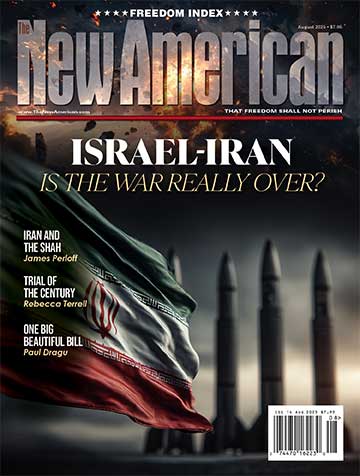It is not new that the Left has used motion pictures as a critical vehicle for the promotion of its views on sundry issues. Vladimir Lenin, the first dictator of the Soviet Union, said the motion picture was the most important art form for spreading communism to other countries. And his successor, the murderous dictator Joseph Stalin, is reported to have predicted he could convert the whole world to communism if he were given control of the American movie industry.
We could list a string of motion pictures that have supported various left-wing causes, in addition to outright communism. Neither Lenin nor Stalin could have predicted TV movies, but HBO launches a five-part miniseries on Monday designed to poison the American public’s collective mind against the safety of nuclear power — by concentrating on the worst accident in the history of the nuclear power industry, which happened inside the old Soviet Union, with Chernobyl.
As is typical with “history” portrayed in movies, Chernobyl is a mixture of fact and fiction. Not surprisingly, the compliant media provides coverage in total support of the miniseries’ premise — the Chernobyl incident is a powerful demonstration that nuclear power generation is simply too dangerous, and we must instead accept a reduced standard of living.
Time magazine’s Judy Berman weighed in: “There’s no bright side to the 1986 reactor explosion that likely killed thousands in Soviet Ukraine, rendering the surrounding area uninhabitable for centuries to come and making the word Chernobyl synonymous with the risks of nuclear energy.” TV Guide opined, “The series portrays in grisly detail what it’s like to die of radiation poisoning,” bluntly summarizing the political message the series is intended to promote: “It doubles as a warning about who pays the cost when the hard facts of science butt up against political agendas.”
Just what are the “hard facts of science,” when it comes to the tragedy of Chernobyl?
First, no one would dispute that radiation sickness is a terrible death. But so is dying in a fiery civilian airplane on the runway in Russia, that killed about 40 people. If people dying in flames were portrayed in graphic detail on a movie screen it would be a horrible sight indeed — but does that mean we should end all civilian airline flights?
Second, it has been noted that the Chernobyl plant was built with no containment structure. Scott Montgomery, a geoscientist, and author of Seeing the Light: The Case for Nuclear Power in the 21st Century, wrote, “No other nation has ever built such technology; it would have been rejected by any regulatory body.”
While Time claimed that the area is uninhabitable, all sorts of animals and vegetation are thriving in the area. Even people live there, and they have done so since shortly after the accident. About a 1,000 mainly old people moved back shortly after the accident — and most are outliving their peers who didn’t return home.
Several thousand deaths have been attributed to Chernobyl, but the consensus places the death toll more in the range of 30-60. While between four and six thousand cases of thyroid cancer might be attributable to the radiation, it is likely that cases of thyroid cancer are simply being caught because people are tested for it — a type of confirmation bias. Too, thyroid cancer has a 99-percent survival rate. In comparison, a large dam (designed to produce electricity) in China (another communist dictatorship) collapsed in 1975, with about 26,000 drowning as a result. Another 145,000 died from the resulting epidemics due to water contamination and famine.
Risk is associated with all energy production. Electrical fires have occurred in wind turbines, which could result in extensive wild fires. Natural gas explosions have killed many, as well. Coal production has had its share of disasters.
In the contaminated area around Chernobyl, it was predicted that there would be huge spikes in cases of leukemia, but it did not happen. No evidence exists that the explosion at Chernobyl produced any fertility problems or birth defects.
In contrast, with the incidents at Three Mile Island in Pennsylvania in 1979 and with Fukushima in 2011, there were no deaths at all. With Fukushima, the deaths in Japan were caused by a tsunami and by government relocation efforts, not a nuclear power plant. And at Three Mile Island, it was often joked at the time that more people have died in the back of Ted Kennedy’s car than at Three Mile Island.
Obviously, deaths in any energy accident — whether it be gas explosions, coal mine collapse, dam failures, fires caused by wind turbines, or nuclear plant explosions — are nothing to laugh about. But the fear of nuclear power is all out of proportion to its dangers. Nuclear power plants — even the badly designed Chernobyl plant — simply cannot explode like a nuclear bomb. Nuclear power production has the fewest casualties among all energy sources, and is also the cleanest, and by far the most productive.
Finally, only a plant designed in the totalitarian nation of the Soviet Union has produced a Chernobyl. No plant ever built, or ever would be built, in the United States, could result in what happened in 1986 under that communist dictatorship. The central problem of the HBO production is that it takes an episode that could never happen anywhere else, and leaves the impression that it is typical of the nuclear power industry.
But such productions are much more likely to attract viewers and sell advertising, and serve to promote the message that our future is grim — and that we must turn more control of our every day lives to government, and accept a radically reduced standard of living.




